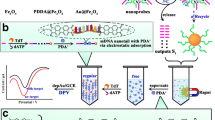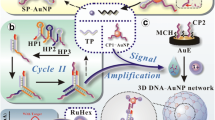Abstract
We have developed a uranyl-specific DNAzyme that was immobilized on the surface of a gold electrode to give a highly sensitive and selective biosensor for uranyl ion. The typical DNAzyme system consisted of the RNA (rA) as the substrate (ADNA), and the other strand is the enzyme (TDNA) with a ferrocene (Fc). The presence of uranyl ion induces the cleavage of the DNA substrate strand at the rA position to form two fragments. The Fc unit thereby is released from the surface of the electrode, and this results in a decreased peak current. This electrochemical biosensor has a dynamic range from 2 nM to 14 nM of uranyl ion, with a detection limit at 1 nM. It exhibits high sensitivity and excellent selectivity over other metal ions, and thus represents a promising technique for simple, fast, on-site, and real-time electrochemical sensing of UO2(II) ion. It also serves as a guide in choosing different methods for designing electrochemical sensors for other metal ions.

We have developed a uranyl-specific DNAzyme that was immobilized on the surface of a gold electrode to give a highly sensitive and selective biosensor for uranyl ion. The typical DNAzyme system consisted of the RNA as the substrate and the other strand is the enzyme with a ferrocene (Fc). This electrochemical biosensor exhibits high sensitivity and excellent selectivity, and represents a promising technique for simple, fast, on-site, and real-time electrochemical sensing of UO2(II) ion.







Similar content being viewed by others
References
Liu J, Brown AK, Meng X, Cropek DM, Istok JD, Watson DB, Lu Y (2007) A catalytic beacon sensor for uranium with parts-per-trillion sensitivity and millionfold selectivity. Proc Natl Acad Sci 104(7):2056–2061
Gongalsky KB (2003) Impact of pollution caused by uranium production on soil macrofauna. Environ Monit Assess 89(2):197–219
Zhou P, Gu B (2005) Extraction of oxidized and reduced forms of uranium from contaminated soils: effects of carbonate concentration and pH. Environ Sci Technol 39(12):4435–4440
Craft ES, Abu-Qare AW, Flaherty MM, Garofolo MC, Rincavage HL, Abou-Donia MB (2004) Depleted and natural uranium: chemistry and toxicological effects. J Toxicol Environ Health B 7(4):297–317
Abbasi SA (1989) Atomic absorption spectrometric and spectrophotometric trace analysis of uranium in environmental samples with N-p-methoxyphenyl-2-furylacrylohydroxamic acid and 4-(2-pyridylazo) resorcinol. Int J Environ Anal Chem 36(3):163–172
Brina R, Miller AG (1992) Direct detection of trace levels of uranium by laser-induced kinetic phosphorimetry. Anal Chem 64(13):1413–1418
Kaminski R, Purcell FJ, Russavage E (1981) Uranyl phosphorescence at the parts-per-trillion level. Anal Chem 53(7):1093–1096
Lorber A, Karpas Z, Halicz L (1996) Flow injection method for determination of uranium in urine and serum by inductively coupled plasma mass spectrometry. Anal Chim Acta 334(3):295–301
Gonzalez JJ, Oropeza D, Mao X, Russo RE (2008) Assessment of the precision and accuracy of thorium (232Th) and uranium (238U) measured by quadrupole based inductively coupled plasma-mass spectrometry using liquid nebulization, nanosecond and femtosecond laser ablation. J Anal At Spectrom 23(2):229–234
Rani A, Mehra R, Duggal V, Balaram V (2013) Analysis of uranium concentration in drinking water samples using ICPMS. Heal Phys 104(3):251–255
Ruan CM, Luo W, Wang W, Gu B (2007) Surface-enhanced Raman spectroscopy for uranium detection and analysis in environmental samples. Anal Chim Acta 605(1):80–86
Liu J, Cao Z, Lu Y (2009) Functional nucleic acid sensors. Chem Rev 109(5):1948–1998
Navani NK, Li Y (2006) Nucleic acid aptamers and enzymes as sensors. Curr Opin Chem Biol 10(3):272–281
Lee JF, Stovall GM, Ellington AD (2006) Aptamer therapeutics advance. Curr Opin Chem Biol 10(3):282–289
Breaker RR, Joyce GF (1994) A DNA enzyme that cleaves RNA. Chem Biol 1(4):223–229
Ellington AD, Szostak JW (1990) In vitro selection of RNA molecules that bind specific ligands. Nature 346(6287):818–822
**ao Y, Rowe AA, Plaxco KW (2007) Electrochemical detection of parts-per-billion lead via an electrode-bound DNAzyme assembly. J Am Chem Soc 129(2):262–263
Shen L, Chen Z, Li YH, He SL, **e SB, Xu XD, Liang ZW, Meng X, Li Q, Zhu ZW, Li MX, Le XC, Shao YH (2008) Electrochemical DNAzyme sensor for lead based on amplification of DNA–Au bio-bar codes. Anal Chem 80(16):6323–6328
Zhang XB, Wang Z, **ng H, **ang Y, Lu Y (2010) Catalytic and molecular beacons for amplified detection of metal ions and organic molecules with high sensitivity. Anal Chem 82(12):5005–5011
Pelossof G, Tel-Vered R, Willner I (2012) Amplified surface plasmon resonance and electrochemical detection of Pb2+ ions using the Pb2+-dependent DNAzyme and hemin/G-quadruplex as a label. Anal Chem 84(8):3703–3709
Wang W, Billen LP, Li Y (2002) Sequence diversity, metal specificity, and catalytic proficiency of metal-dependent phosphorylating DNA enzymes. Chem Biol 9(4):507–517
Santoro SW, Joyce GF, Sakthivel K, Gramatikova S, Barbas CF (2000) RNA cleavage by a DNA enzyme with extended chemical functionality. J Am Chem Soc 122(11):2433–2439
Lu CH, Wang F, Willner I (2012) Zn2+-ligation DNAzyme-driven enzymatic and nonenzymatic cascades for the amplified detection of DNA. J Am Chem Soc 134(25):10651–10658
Wang Y, Silverman SK (2003) Deoxyribozymes that synthesize branched and lariat RNA. J Am Chem Soc 125(23):6880–6881
Zhu ZQ, Su YY, Li J, Li D, Zhang J, Song SP, Zhao Y, Li GX, Fan C (2009) Highly sensitive electrochemical sensor for mercury(II) ions by using a mercury-specific oligonucleotide probe and gold nanoparticle-based amplification. Anal Chem 81(18):7660–7666
Yu CJ, Wang H, Wan Y, Yowanto H, Kim JC, Donilon LH, Tao C, Strong M, Chong Y (2001) 2′-Ribose-ferrocene oligonucleotides for electronic detection of nucleic acids. J Org Chem 66(99):2937–2942
Patolsky F, Weizmann Y, Willner I (2002) Redox active nucleic-acid replica for the amplified bioelectrocatalytic detection of viral DNA. J Am Chem Soc 124(5):770–772
Gibbs JM, Park SJ, Anderson DR, Watson KJ, Mirkin CA, Nguyen ST (2005) Polymer–DNA hybrids as electrochemical probes for the detection of DNA. J Am Chem Soc 127(4):1170–1178
Cardona CM, Kaifer AE (1998) Asymmetric redox-active dendrimers containing a ferrocene subunit preparation, characterization, and electrochemistry. J Am Chem Soc 120(16):4023–4024
Lee JH, Wang Z, Liu J, Lu Y (2008) Highly sensitive and selective colorimetric sensors for uranyl (UO22+): Development and comparison of labeled and label-free DNAzyme-gold nanoparticle systems. J Am Chem Soc 130(43):14217–14226
Acknowledgments
The authors gratefully acknowledge the support of the Open Foundation of State Key Laboratory of Chemo/Biosensing and Chemometrics, Hunan University, China, the Natural Science Foundation of China (No.31200140) and the Starting Foundation for High-Scientific Study of Genius from University of South China under the Grant 2011XQD58.
Author information
Authors and Affiliations
Corresponding author
Rights and permissions
About this article
Cite this article
Tang, Q., Yuan, Y., **ao, X. et al. DNAzyme based electrochemical sensors for trace uranium. Microchim Acta 180, 1059–1064 (2013). https://doi.org/10.1007/s00604-013-1021-8
Received:
Accepted:
Published:
Issue Date:
DOI: https://doi.org/10.1007/s00604-013-1021-8




